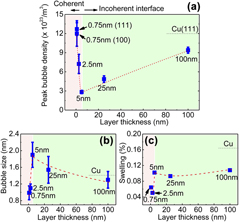Crossref Citations
This article has been cited by the following publications. This list is generated based on data provided by
Crossref.
Du, J. L.
Fang, Y.
Fu, E. G.
Ding, X.
Yu, K. Y.
Wang, Y. G.
Wang, Y. Q.
Baldwin, J. K.
Wang, P. P.
and
Bai, Q.
2016.
What determines the interfacial configuration of Nb/Al2O3 and Nb/MgO interface.
Scientific Reports,
Vol. 6,
Issue. 1,
Shao, S.
and
Wang, J.
2016.
Relaxation, Structure, and Properties of Semicoherent Interfaces.
JOM,
Vol. 68,
Issue. 1,
p.
242.
Li, Jin
Chen, Y.
Xue, S.
Wang, H.
and
Zhang, X.
2016.
Comparison of size dependent strengthening mechanisms in Ag/Fe and Ag/Ni multilayers.
Acta Materialia,
Vol. 114,
Issue. ,
p.
154.
Chen, Y.
Zhang, X.
and
Wang, J.
2016.
Radiation Enhanced Absorption of Frank Loops by Nanovoids in Cu.
JOM,
Vol. 68,
Issue. 1,
p.
235.
Chen, Y.
Li, N.
Bufford, D.C.
Li, J.
Hattar, K.
Wang, H.
and
Zhang, X.
2016.
In situ study of heavy ion irradiation response of immiscible Cu/Fe multilayers.
Journal of Nuclear Materials,
Vol. 475,
Issue. ,
p.
274.
Li, Nan
Demkowicz, Michael J.
and
Mara, Nathan A.
2017.
Microstructure Evolution and Mechanical Response of Nanolaminate Composites Irradiated with Helium at Elevated Temperatures.
JOM,
Vol. 69,
Issue. 11,
p.
2206.
Si, Shuyao
Li, Wenqing
Zhao, Xiaolong
Han, Meng
Yue, Yanan
Wu, Wei
Guo, Shishang
Zhang, Xingang
Dai, Zhigao
Wang, Xinwei
Xiao, Xiangheng
and
Jiang, Changzhong
2017.
Significant Radiation Tolerance and Moderate Reduction in Thermal Transport of a Tungsten Nanofilm by Inserting Monolayer Graphene.
Advanced Materials,
Vol. 29,
Issue. 3,
Dong, Lan
Zhang, Hongxiu
Amekura, Hiroshi
Ren, Feng
Chettah, Abdelhak
Hong, Mengqing
Qin, Wenjing
Tang, Jun
Hu, Lulu
Wang, Hui
and
Jiang, Changzhong
2017.
Period-thickness dependent responses of Cu/W multilayered nanofilms to ions irradiation under different ion energies.
Journal of Nuclear Materials,
Vol. 497,
Issue. ,
p.
117.
Zhang, Xinghang
Hattar, Khalid
Chen, Youxing
Shao, Lin
Li, Jin
Sun, Cheng
Yu, Kaiyuan
Li, Nan
Taheri, Mitra L.
Wang, Haiyan
Wang, Jian
and
Nastasi, Michael
2018.
Radiation damage in nanostructured materials.
Progress in Materials Science,
Vol. 96,
Issue. ,
p.
217.
Li, Jin
Wang, H.
and
Zhang, X.
2018.
A Review on the Radiation Response of Nanoporous Metallic Materials.
JOM,
Vol. 70,
Issue. 11,
p.
2753.
Fu, Kunkun
Sheppard, Leigh R.
Chang, Li
An, Xianghai
Yang, Chunhui
and
Ye, Lin
2018.
Length-scale-dependent nanoindentation creep behaviour of Ti/Al multilayers by magnetron sputtering.
Materials Characterization,
Vol. 139,
Issue. ,
p.
165.
Chen, J.
Mathaudhu, S.N.
Thadhani, N.
and
Dongare, A.M.
2019.
Correlations between dislocation density evolution and spall strengths of Cu/Ta multilayered systems at the atomic scales: The role of spacing of KS interfaces.
Materialia,
Vol. 5,
Issue. ,
p.
100192.
Yang, Wenfan
Pang, Jingyu
Zheng, Shijian
Wang, Jian
Zhang, Xinghang
and
Ma, Xiuliang
2019.
Interface Effects on He Ion Irradiation in Nanostructured Materials.
Materials,
Vol. 12,
Issue. 16,
p.
2639.
Mei, Zhi-Gang
Bhattacharya, Sumit
and
Yacout, Abdellatif M.
2019.
First-principles study of fracture toughness enhancement in transition metal nitrides.
Surface and Coatings Technology,
Vol. 357,
Issue. ,
p.
903.
Zhang, Y.F.
Xue, S.
Li, Q.
Li, Jin
Ding, Jie
Niu, T.J.
Su, R.
Wang, H.
and
Zhang, X.
2019.
Size dependent strengthening in high strength nanotwinned Al/Ti multilayers.
Acta Materialia,
Vol. 175,
Issue. ,
p.
466.
Liang, X.Q.
Wang, Y.Q.
Zhao, J.T.
Wu, S.H.
Feng, X.B.
Wu, K.
Zhang, J.Y.
Liu, G.
and
Sun, J.
2019.
Size-dependent microstructure evolution and hardness of He irradiated Nb/Zr multilayers under different ion doses.
Materials Science and Engineering: A,
Vol. 764,
Issue. ,
p.
138259.
Sáenz-Trevizo, A
and
Hodge, A M
2020.
Nanomaterials by design: a review of nanoscale metallic multilayers.
Nanotechnology,
Vol. 31,
Issue. 29,
p.
292002.
Derby, Benjamin K.
Baldwin, Jon Kevin
Wang, Yongqiang
Demkowicz, Michael J.
Misra, Amit
and
Li, Nan
2020.
Influence of metal nanocomposite morphology on Helium implantation response.
Scripta Materialia,
Vol. 177,
Issue. ,
p.
229.
Yadav, Digvijay
Zhao, Dexin
Baldwin, Jon Kevin
Devaraj, Arun
Demkowicz, Michael J.
and
Xie, Kelvin Y.
2021.
Persistence of crystal orientations across sub-micron-scale “super-grains” in self-organized Cu-W nanocomposites.
Scripta Materialia,
Vol. 194,
Issue. ,
p.
113677.
Gupta, Naveen
and
Kumar, Sandeep
2021.
Generation of second harmonics of relativistically self-focused q-Gaussian laser beams in underdense plasma with axial density ramp.
Optical and Quantum Electronics,
Vol. 53,
Issue. 4,





